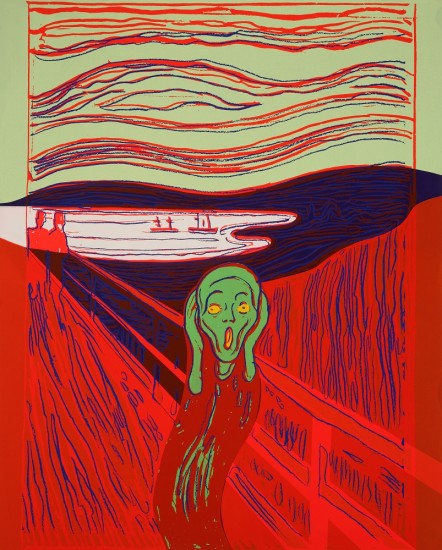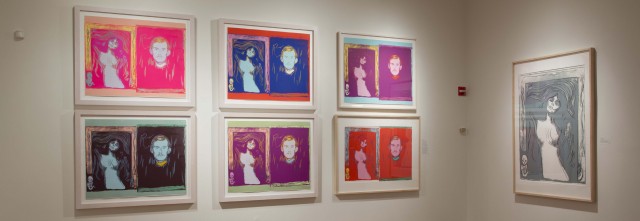
Andy Warhol, “The Scream (After Munch),” screenprint on Lenox Museum Board, 1984 (© 2013 The Andy Warhol Foundation for the Visual Arts, Inc. / Artists Rights Society, New York)
Scandinavia House
58 Park Ave. at 38th St.
Tuesday-Saturday through July 27, $5, 12 noon – 6:00 pm
212-847-9740
www.scandinaviahouse.org
“Isn’t life a series of images that change as they repeat themselves?” Andy Warhol rhetorically asked. “I have no fear of photography as long as it cannot be used in heaven and in hell,” Edvard Munch explained. Shortly after a 1982 Munch exhibition, New York’s Galleri Bellman commissioned Warhol (1928-87) to create pieces based on the work of Munch (1863-1944). The pairing of the two men — one a fame-obsessed pop-culture junkie with a very particular public persona, the other a deeply personal artist who explored dark psychological themes and suffered from severe anxiety — actually makes a lot of sense, as each experimented with printing techniques for both artistic and commercial purposes. As part of Munch 150, a worldwide celebration of the Norwegian painter’s 150th birthday, Scandinavia House is hosting “Munch | Warhol and the Multiple Image,” which brings together works by the two printmakers. For the Galleri Berman commission, Warhol chose Munch’s “Madonna,” “Self-Portrait,” “The Brooch. Eva Mudocci,” and “The Scream,” tracing photographic blow-ups of the original image, breaking them down into their bare elements and then re-creating them, incorporating different colors, ghostly doubling, and other effects that give new life to Munch’s famous images. The exhibition, splendidly curated by Dr. Patricia G. Berman and Pari Stave, consists of thirty-two prints, including multiple versions of Munch’s controversial “Madonna,” in which he sexualizes his dark-haired subject, adding spermatozoa and an infant in many of the works, and a pair of self-portraits, one a trial proof never before displayed in America, in which his head and upper body seem to be floating in a dark nothingness. In a series of eight diptychs titled “Madonna and Self-Portrait with Skeleton’s Arm (After Munch),” Warhol places the images side-by-side, changing color and resolution, desexualizing and resexualizing the woman as her initial artistic creator stares blankly at the viewer. Warhol’s psychedelic versions of musician Mudocci include the tracing that has a hint of Michael Jackson in the face. In the back room is a nearly dizzying series of “The Scream (After Munch),” as Warhol and his master printmaker, Rupert Jason Smith, play with line, form, and color, altering the prominence of the background and foreground, each screenprint providing different emotional takes on Munch’s iconic, oft-reproduced image.

“Munch | Warhol” exhibit brings together two iconic printmakers (photo by Eileen Travell. Scandinavia House/The American-Scandinavian Foundation, 2013)
Ultimately, it’s that repetition, with minor or major changes, that most directly link the two artists, both of whom reworked their originals over and over again to create commercially viable multiples. As it turned out, Warhol’s Munch-based lithographs were never published as an edition, the multiples never released as a multiple of its own. “Munch | Warhol and the Multiple Image” continues at Scandinavia House through July 27; on July 23 at 6:30, Dr. Jay A. Clarke will give the lecture “Munch’s Repetition” (free but advance RSVP suggested), and there will be a docent-led tour on July 27 at 1:00.